CollegeVine personas classify students into one of six distinct archetypes based on their college motivations. We use this data on our platform to provide better guidance for our students and enable our college partners to personalize their outreach and presentation to students.
Methodology
Students responded to our College Preferences Survey, allowing us to understand their goals and interests. Each student’s responses corresponded to a primary persona, which we use when analyzing the distribution across all personas. Each student has a percentage “match” with each persona, however.
You can see an example of a specific student’s profile and their match with the personas below.
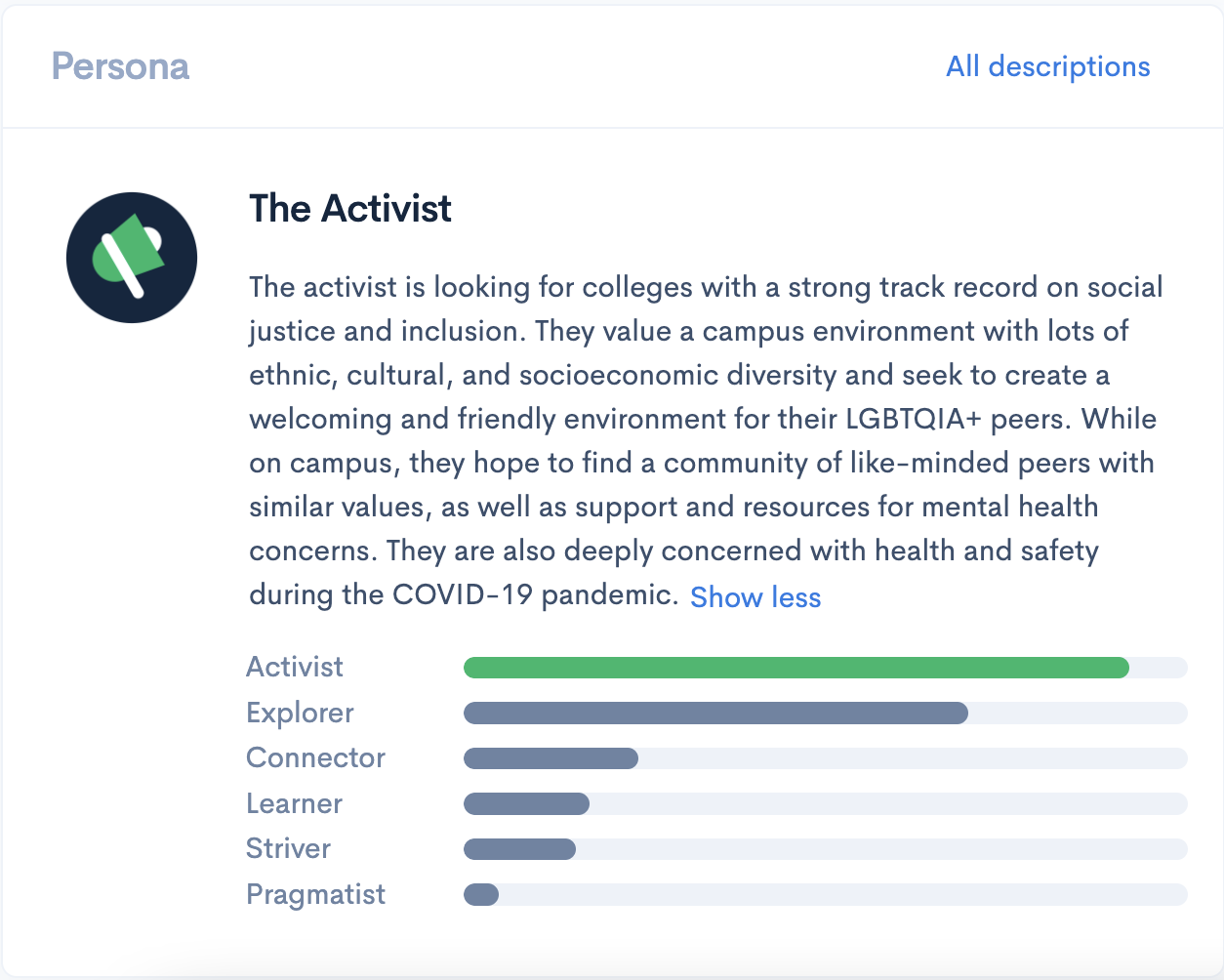
The most common primary personas may change over time, depending on the students who respond to the survey. That said, the current breakdown as of March 2022 is:
| Striver | Connector | Activist | Explorer | Pragmatist | Learner |
| 21.5% | 19.9% | 18.2% | 17.6% | 13.1% | 9.7% |
Overview of the Personas
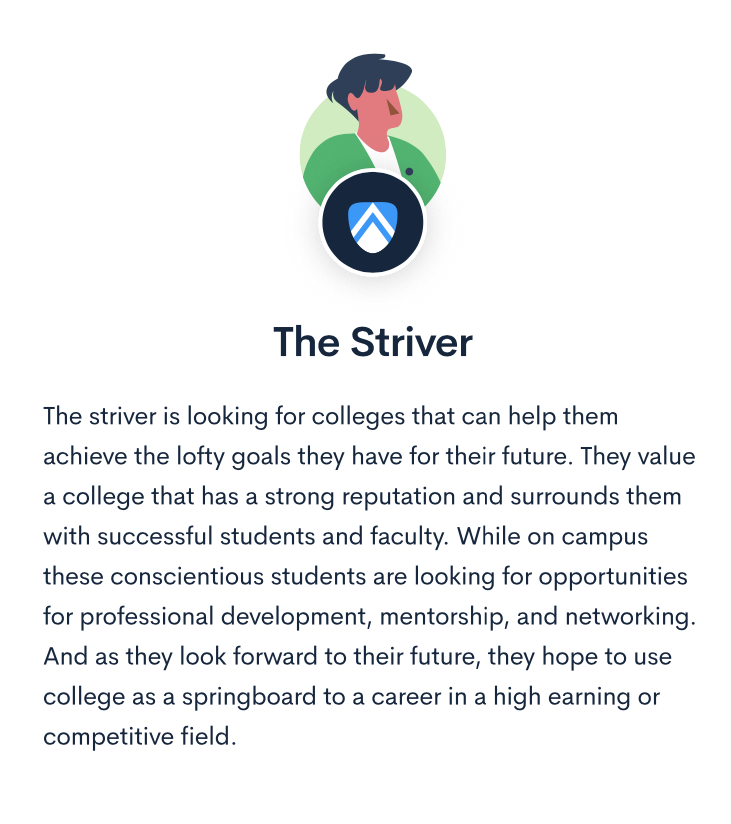
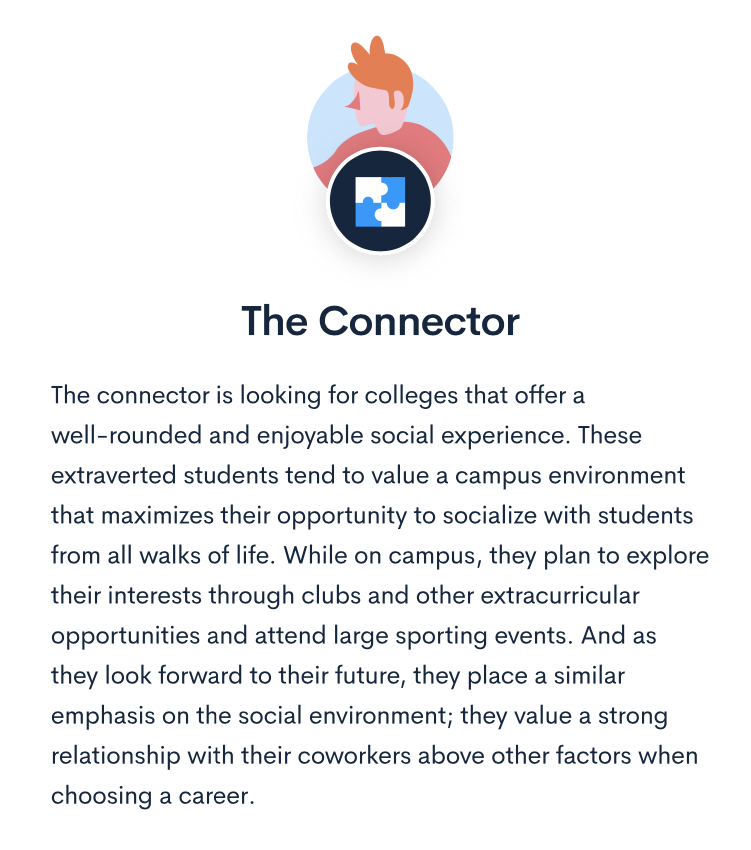
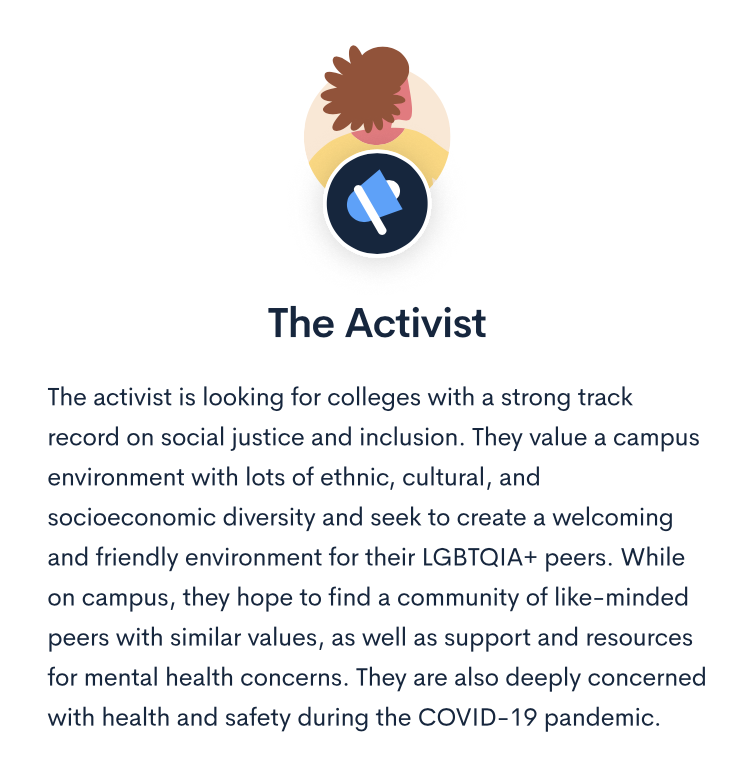
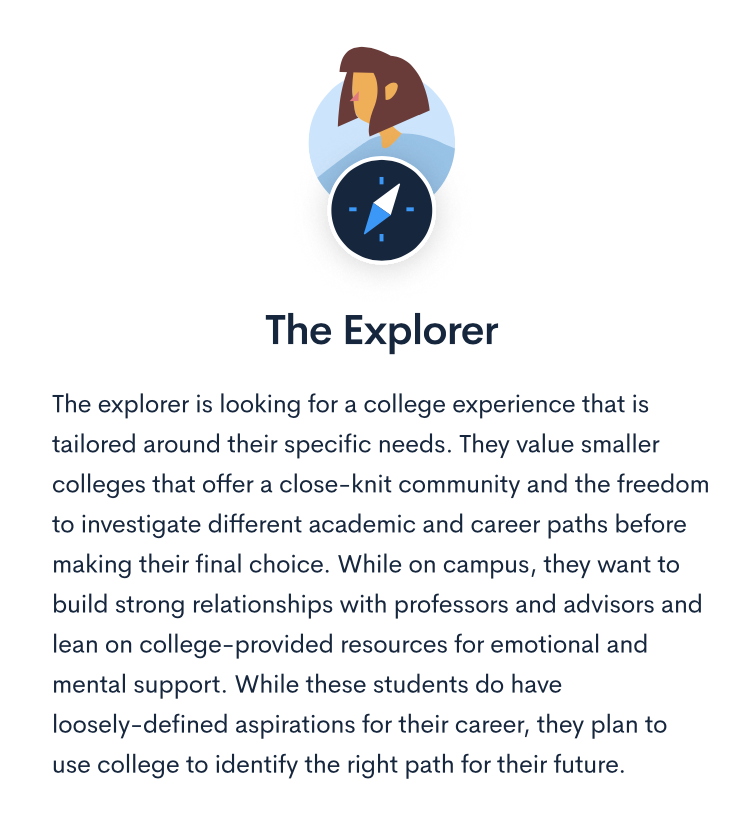

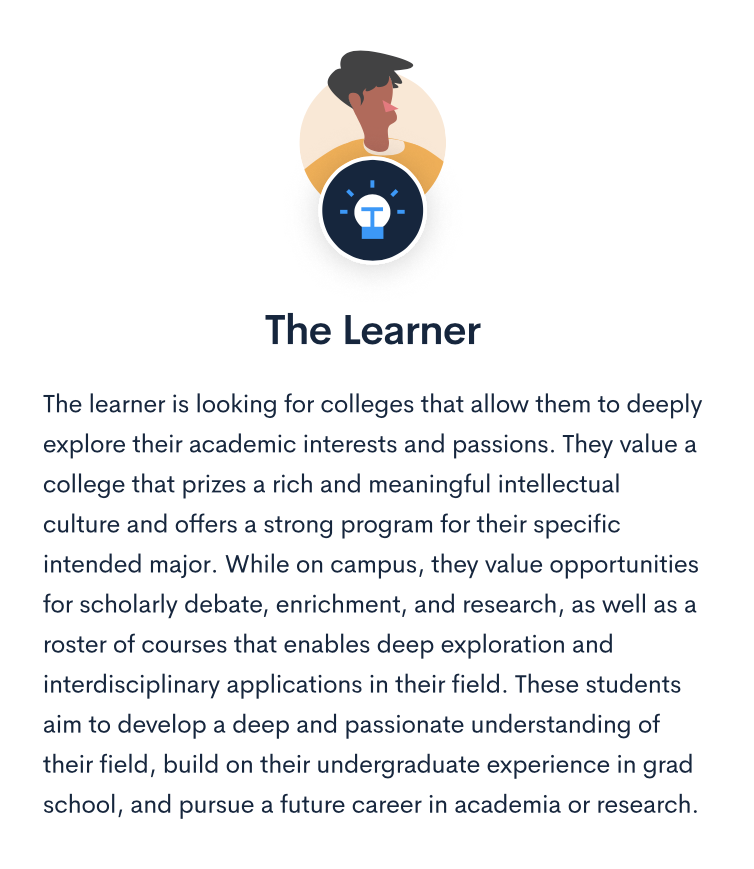
Communicating with Strivers
Alumni spotlight: Showcase 2-3 alumni who have achieved a high degree of success after graduation. These can be more recent alumni who are on a strong trajectory, or older alumni who are at the very top of their fields.
Alumni network overview: Highlight data on your alumni network, including the types of industries they work in, their geographic distribution, and more. Visualizations and graphics can make this data more legible for your audience.
Student honors: Showcase any special awards or recognitions that students are able to achieve on campus. These can be purely academic or more holistically determined.
Building Affinity with Strivers
Set up an alumni panel: The best version of this session has successful alumni from different backgrounds and distinct fields.
Host a resume development session: A session for prospective applicants (run by career services) that walks through how to build a professional resume and LinkedIn profile.
Host a professional grad school pathway presentation: A session walking through the pathway that students will take through undergrad to a professional graduate program (e.g. med school or law school).
Facilitate a meeting with a career advisor: This meet will help prospective students understand the career support and resources offered at the college.
Communicating with Connectors
Gameday experience: Highlight the unique game day experiences and traditions for your strongest sports teams. This can include the success of the team, unique traditions, or rituals like tailgating.
Student groups and social life: Highlight 2-3 student groups (including Greek life if inclined) that serve a primarily social purpose. Share the perspective of students in those groups and how that helped them find community on campus.
Collaborative coursework: Showcase courses in different majors that are centered around collaborative work between students. Share the perspective of students in those courses on how that enhanced their learning experience.
Building Affinity with Connectors
Give away free tickets to a sporting event: The sporting event in question should be a popular spectator sport (football, basketball, baseball, or ice hockey at most institutions)
Host a student social life panel: The best version of this event has students with diverse interests and backgrounds, from athletics to niche clubs.
Put on a student group fair: This is typically held during an accepted students day and features tables with representatives from student groups.
Set up a virtual mixer for accepted or prospective students: Hold a virtual event to allow small groups of accepted or prospective students to get to know each other (similar to orientation).
Communicating with Activists
Activism opportunities: Highlight 4-5 activism or social-justice oriented student groups on your campus. If you can, aim to spotlight unique affinity groups as well as the tangible impact student groups have had in changing policies, raising awareness, or driving charitable donations.
Welcoming community on campus: Share the perspective of 2-3 students from a marginalized background who feel that your institution has created a welcoming environment for students like them. Their stories should illustrate the formal efforts of institutional policy and faculty, as well as the impact of the broader student community.
Keeping students safe from COVID-19: Showcase the approach your institution has taken to combat the effects of the COVID-19 pandemic. If you can, point to the track record of your school in minimizing cases, vaccinations, and keeping the community around you safe as well.
Building Affinity with Activists
Set up a student diversity panel: The best version of this panel features students that highlight the ethnic, socioeconomic, and geographic diversity of your campus.
Host an affinity group presentation: This can either feature a single affinity group or representatives from multiple affinity groups.
Set up a faculty panel: This should feature faculty members discussing how social justice is built into their curriculum and teaching philosophy.
Communicating with Explorers
Student case studies: Highlight the story of 2-3 students who ended up changing their majors and figured out their intended career thanks to the flexibility offered by your institution
Professor mentorship: Showcase 2-3 professor-student mentorship relationships that helped the student overcome obstacles or achieve their intended goals. Try to feature perspective from both the students and the professors
Campus community: Share the perspective of 2-3 students who feel that your institution has created a strong community for students like them. Their stories should illustrate the formal community structure like housing communities, as well as the impact of the broader student culture.
Building Affinity with Explorers
Facilitate a presentation from an academic advisor: This should highlight academic flexibility and advising, and can be part of a broader info session or a discrete session by itself.
Set up a student panel: Invite students from diverse backgrounds to discuss the campus community and culture.
Host an experiential learning info session: The best version of this info session features both students and faculty members associated with experiential learning opportunities on campus.
Communicating with Pragmatists
Student outcomes spotlight: Highlight the success of your graduates by presenting metrics and information regarding graduation, job placement, and ROI at the institutional and major-specific level. Visualizations and graphics can make the data more legible for your audience.
Career advising: Showcase the story of 2-3 students who leveraged career development resources on your campus to find a job in their field after graduation. Try to highlight both their use of career services and advising resources, as well as programs and opportunities on campus that helped them build experience and their resume.
Experiential learning programs: Showcase opportunities on campus for experiential learning. Be sure to highlight the ways practical learning is woven into the classroom experience while also surfacing supplemental opportunities and programs such as co-ops, externships, and more.
Building Affinity with Pragmatists
Set up an alumni panel: Invite successful alumni from distinct fields to speak about their professional paths.
Host an experiential learning info session: This event should feature both students and faculty members associated with experiential learning opportunities on campus.
Communicating with Learners
Courses: Highlight 4-5 interesting courses that your school offers in their major program. Focus on unique or interdisciplinary that are relatively unique to your school and department.
Faculty spotlight: Showcase 2-3 faculty members in the department associated with the student’s intended major. Highlight that faculty member’s research, work outside of academia, and teaching philosophy.
Grad school pathway: Showcase how your school positions students for phd programs and a future career in academia. If available try to highlight specific statistics like placement rates, the number of students who move on to grad school, etc.
Building Affinity with Learners
Facilitate a conversation with a student or professor: Connect the prospective student(s) to a current student or professor in their major department. This can be one-on-one, or in a small group.
Host a major-specific info session: The best version of this session has both an admissions representative and a faculty member or department head.
Allow a prospective student to sit in on a class: This can be done live or via a recorded session.
Final Thoughts
Leveraging CollegeVine personas can help you personalize your recruitment efforts and better connect with students.
To explore prospective students, sign up for CollegeVine’s free recruiting dashboard, which allows you to view student profiles and build one-on-one connections with our diverse student base.
And for more college enrollment insights, subscribe to our mailing list below, where we’ll send weekly updates!
